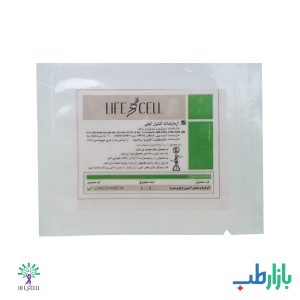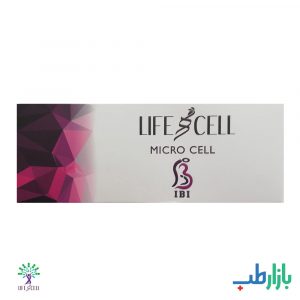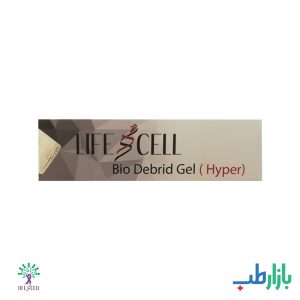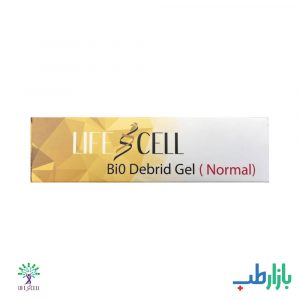لایف سل - Life Cell
در حال نمایش 4 نتیجه
لایف سل
یکی از شرکتهای پیشرو در زمینه بیوتکنولوژی سلولهای بنیادین و تولید بایومتریال بوده و بعنوان قطب فناوری های پیشرفته در حوزه سلولهای بنیادین و فراورده های مرتبط با محصولات پزشکی و مهندسی پزشکی ، دارویی و مکملهای حوزه سلامت بخش مهمی از محصولات کیفی مورد نیاز جامعه سلامت را برعهده دارد.
معرفی لایف سل
از سال 2009 هولدینگ بین المللی لایف سل، محصولات خود را با فناوری بیوتکنولوژیک مشابه کمپانیهای معظمی همچون برامتون انگلستان، لایف سل آمریکا و سنو بیولوژیک انگلستان و مدکستندر آلمان تولید و عرضه مینماید.
این محصولات در حوزه سلولهای بنیادین و فاکتورهای رشد در آلوگرفتهای کیسه جنینی با جدیدترین تکنولوژی دنیا مطابق با گایدلاین FDA آمریکا (HCT/P) (21 CFR Part 1271) و طبق ضوابط استاندارد مهندسی بافت AATB آمریکا و دارای مجوز از وزارت بهداشت ایران به شماره 65273027 تولید می باشد
اکنون شرکت لایف سل یکی از شرکتهای پیشرو در زمینه بیوتکنولوژی سلولهای بنیادین و تولید بایومتریال بوده و بعنوان قطب فناوری های پیشرفته در حوزه سلولهای بنیادین و فراورده های مرتبط با محصولات پزشکی و مهندسی پزشکی، دارویی و مکملهای حوزه سلامت بخش مهمی از محصولات کیفی مورد نیاز جامعه سلامت را برعهده دارد.
استفاده از فناوری پیشرفته علوم بایونانو زیستی در مهندسی بافت مبتنی بر سلولهای بنیادین و فراورده های آن واستفاده از پیشرفته ترین مواد موثره لیپوزومیک و کنترل ریلیز امکان دسترسی به کیفی ترین محصولات جامعه درمان را توسط این شرکت فراهم نموده است . طیف محصولات تولیدی بسیار گسترده در زمینه های درمانی پزشکی میباشد.
اخذ گواهینامه های بین المللی جهت تولید محصولات و مواد موثره همچون ISO 13485/2016 و (HCT/P) (21 CFR Part 1271) و تولید بر مبنای EUGMP و ضوابط AATB آمریکا در سایت پیشرفته تولید مطابق با GMP و CGMP و نیز دارا بودن سیستمهای مدیریت کیفیت همچون MOH / 65273027 ، MOI / 60556 ، ISO 9001 ، ISO 14001 ، OHSAS 18001 زمینه تولید بین المللی محصولات بیوتکنولوژی درمان زخم را در این شرکت فراهم آورده است شرکت لایف سل امروزه با گذشت بیش از یک و نیم دهه ، کماکان به عنوان رقیبی جدی با شرکتهای طراز اول دنیا همچون mimedx و genesis امریکا با محصولات بی رقیب در بازار تلقی میشود.
لایفسل در سال ۱۳۸۶ با تکیه بر دانش مهندسین داخلی و همکاری کمپانیهای معتبر دنیا فعالیت خود را در زمینه تولید دارو و دستیابی به جدیدترین شیوههای درمانی بر پایه زیست فنآوری (Biotechnology) آغاز به کار کرد. لایفسل در اولین گام خود اقدام به راهاندازی خط تولید پانسمانهای بیولوژیک زنده مبتنی بر غشاء آمنیون در درمان انواع زخم نمود که امروزه و با گذشت بیش از یک ونیم دهه از عمر این محصول، کماکان به عنوان رقیبی جدی برای تولیدات خارجی و محصولی بی رقیب در بازار تلقی میشود. قرن بیست و یکم، قرن بازگشت به طبیعت نام گرفته و اکثر محققین علوم دارویی و پزشکی و موسسات پژوهشی معتبر دنیا و کارخانجات داروسازی توجه جدی خود را به زیست فناوری معطوف نموده اند.
این محصولات پیشرفته بیوتکنولوژی در درمان انواع زخم حاوی سلولهای بنیادین مزانکایمال و آنتی بادیهای مربوطه ، فاکتورهای رشد ، سایتوکین ها ، ماتریکس خارج سلولی ، هیالورونیک اسید و بایواکتیوهای مورد نیاز فرایند های درمانی پزشکی هستند و بواسطه کیفیت بسیار بالا و فناوری پیشرفته ، مراکز مهم درمانی کشور را تحت پوشش قرارداده اند . درفرایند بیوتکنولوژی تولید این محصولات استریل کلیه غربالگریها از حیث بیماریهای مزمن ، عفونی ، نورولوژیک و اتوایمیون و آزمایشات کنترل کیفی سرولوژیک و باکتریولوژیک طبق ضوابط TEMP و استاندارد AATB آمریکا انجام میپذیرد تا محصولی استریل و سلامت عرضه شود.
گروه لایف سل بعنوان يک مجموعه دانش بنيان که توسط معاونت علمي و فناوري رياست جمهوري مورد تاييد واقع شده ، از سال 1380 با هدف توسعه علم و تکنولوژي هاي نوين علوم پزشکي و زيست فناوری به صورت يک هلدينگ در زمينه هاي ، بيوتکنولوژي ،داروسازي ، پزشکي سلامت و زيبايي در حال فعاليت است.
رفرنس ها:
- هولدینگ بین المللی لایف سل ، محصولات بیوتکنولوژی خود را باسیستم بین المللی تضمین کیفیت ارایه مینماید در این راستا مجوزات و تاییدیه های بسیاری اخذ شده است که برخی عبارتند از:
- تاییدیه از وزارت بهداشت، درمان و آموزش پزشکی و پروانه ساخت به شماره 251317/664
- پروانه بهره برداری از وزارت صنایع و معادن ایران به شماره 60556
- تاییدیه استریلیتی از انستیتو پاستور ایران به شماره 65/م
- تاییدیه غیر سمی بودن از آزمایشگاه های پژوهشگاه پلیمر، پتروشیمی و ژنتیک ایران
- تاییدیه های متعدد از سوی متخصصین محترم جراحی پوست و چشم
- تاییدیه و گواهی شرکت دانش بنیان و دارای فناوری برتر از سوی گسترش و نوسازی صنایع ایران به شماره 16730/91
- تاییدیه های استاندارد بین المللی و مدیریت کیفیت از BRS انگلستان
- تاییدیه های سیستمی تضمین کیفیت همچون ISO 9001 ، ISO 14001 ، OHSAS 18001 ، ISO 13485 ، IMS
- تاییدیه مهمترین مرکز تخصصی زخم USA Wound در قالب مقاله تخصصی
- تاییدیه مهمترین مرکز چشم پزشکی اروپا ASCRS
مراجع:
Wound Healing
Mohajeri-Tehrani, Mohammad Reza, et al. “Comparison of a Bioimplant Dressing With a Wet Dressing for the Treatment of Diabetic Foot Ulcers: A Randomized, Controlled Clinical Trial.” Wounds: a compendium of clinical research and practice 28.7 (2016): 248-254
Valiente, Mónica Rodríguez, et al. “Cryopreserved amniotic membrane in the treatment of diabetic foot ulcers: a case series.” Journal of wound care 27.12 (2018): 806-815
Mao, Yong, et al. “The Effect of Cryopreserved Human Placental Tissues on Biofilm Formation of Wound-Associated Pathogens.” Journal of functional biomaterials 9.1 (2018): 3
Gibbons, Gary W. “Grafix®, a cryopreserved placental membrane, for the treatment of chronic/stalled wounds.” Advances in wound care 4.9 (2015): 534-544
Duan-Arnold, Yi, et al. “Retention of endogenous viable cells enhances the anti-inflammatory activity of cryopreserved amnion.” Advances in wound care 4.9 (2015): 523-533
Duan-Arnold, Yi, et al. “Angiogenic potential of cryopreserved amniotic membrane is enhanced through retention of all tissue components in their native state.” Advances in wound care 4.9 (2015): 513-522
Hanselman, Andrew E., John E. Tidwell, and Robert D. Santrock. “Cryopreserved human amniotic membrane injection for plantar fasciitis: a randomized, controlled, double-blind pilot study.” Foot & ankle international 36.2 (2015): 151-158
درمان زخم بستر:
Sheikh, Emran S., Ednan S. Sheikh, and Donald E. Fetterolf. “Use of dehydrated human amniotic membrane allografts to promote healing in patients with refractory non healing wounds.” International wound journal 11.6 (2014): 711-717
Al-Waili, Noori, Khelod Salom, and Ahmad A. Al-Ghamdi. “Honey for wound healing, ulcers, and burns; data supporting its use in clinical practice.” The scientific world journal 11 (2011): 766-787
Gibbons, Gary W. “Grafix®, a cryopreserved placental membrane, for the treatment of chronic/stalled wounds.” Advances in wound care 4.9 (2015): 534-544
درمان زخم سوختگی:
Eskandarlou, Mahdi, et al. “The healing effect of amniotic membrane in burn patients.” World journal of plastic surgery 5.1 (2016): 39
Payne, Wyatt G., et al. “Effect of amnion-derived cellular cytokine solution on healing of experimental partial-thickness burns.” World journal of surgery 34.7 (2010): 1663-1668
Mohammadi,AA.,Riazi,H.,Hasheminasab,MJ.,Sabet,B.,Mohammadi,Mk.,Abbasi,S.Amini,M.,2009.Amnioti Membrane Dressing vs Conventional Topical Antibiotic Dressing in Hospitalized Burn Patients. Iranian Red Crescent Medical Journal,PP.67-70
Marcikic G., Atanasova E., Obocki E., Ugrinovska.,1 Andonovski D., Vasilevska V., Mircevska-Zogovska E. 2008. The advantages of the application of amnion membrane in the treatment of burns. Contributions, Sec. Biol. Med. Sci. XXIX/1, 183–198
6. Mohammadi,AA.,Riazi,H., Hasheminasab,MJ., Sabet,B.,Mohammadi,Mk., Abbasi,S., Amini,M.,2009. Amniotic Membrane Dressing vs Conventional Topical Antibiotic Dressing in Hospitalized Burn Patients. Iranian Red Crescent Medical Journal,PP.67-70
Mostaque, Abul K., and Khairul BM Abdur Rahman. “Comparisons of the effects of biological membrane (amnion) and silver sulfadiazine in the management of burn wounds in children.” Journal of Burn Care & Research 32.2 (2011): 200-209
درمان زخم های عروقی وریدی:
Tauzin, H., et al. “Human amniotic membrane in the management of chronic venous leg ulcers.” Annales de dermatologie et de venereologie. Vol. 138. No. 8-9. 2011
Mermet, Isabelle, et al. “Use of amniotic membrane transplantation in the treatment of venous leg ulcers.” Wound repair and regeneration 15.4 (2007): 459-464
Serena, Thomas E., et al. “A multicenter, randomized, controlled clinical trial evaluating the use of dehydrated human amnion/chorion membrane allografts and multilayer compression therapy vs. multilayer compression therapy alone in the treatment of venous leg ulcers.” Wound Repair and Regeneration 22.6 (2014): 688-693
Litwiniuk, Małgorzata, et al. “Potential role of metalloproteinase inhibitors from radiation sterilized amnion dressings in the healing of venous leg ulcers.” Molecular medicine reports 6.4 (2012): 723-728
Bianchi, Christian, et al. “A multicentre randomised controlled trial evaluating the efficacy of dehydrated human amnion/chorion membrane (EpiFix®) allograft for the treatment of venous leg ulcers.” International wound journal 15.1 (2018): 114-122
درمان زخمهای جراحی عمومی:
Insausti, Carmen L., et al. “Amniotic membrane induces epithelialization in massive posttraumatic wounds.” Wound repair and regeneration 18.4 (2010): 368-377
Koob, Thomas J., et al. “Biological properties of dehydrated human amnion/chorion composite graft: implications for chronic wound healing.” International wound journal 10.5 (2013): 493-500
Koob, Thomas J., et al. “Properties of dehydrated human amnion/chorion composite grafts: implications for wound repair and soft tissue regeneration.” Journal of Biomedical Materials Research Part B: Applied Biomaterials 102.6 (2014): 1353-1362
Arai, Naoya, et al. “Clinical application of a hyperdry amniotic membrane on surgical defects of the oral mucosa.” Journal of Oral and Maxillofacial Surgery 70.9 (2012): 2221-2228
Kothari, Chaitanya R., et al. “Use of amnion as a graft material in vestibuloplasty: a clinical study.” British Journal of Oral and Maxillofacial Surgery 50.6 (2012): 545-549
Sarwar, Iram, et al. “VAGINOPLASTY BY USING AMNION GRAFT IN PATIENTS OF VAGINAL AGENESIS ASSOCIATED WITH MAYOR-ROKITANSKYKUSTER-HAUSER SYNDROME.” Journal of Ayub Medical College Abbottabad 22.1 (2010): 7-10
درمان ضایعه پوستی تومورهای سرطانی:
Niknejad, Hassan, et al. “Human amniotic epithelial cells induce apoptosis of cancer cells: a new anti-tumor therapeutic strategy.” Cytotherapy 16.1 (2014): 33-40
Niknejad, Hassan, et al. “Inhibition of HSP90 could be possible mechanism for anti-cancer property of amniotic membrane.” Medical hypotheses 81.5 (2013): 862-865
Kang, Nam-Hee, et al. “Human amniotic membrane-derived epithelial stem cells display anticancer activity in BALB/c female nude mice bearing disseminated breast cancer xenografts.” International journal of oncology 40.6 (2012): 2022-2028
Niknejad, Hassan, Ghasem Yazdanpanah, and Abolhassan Ahmadiani. “Induction of apoptosis, stimulation of cell-cycle arrest and inhibition of angiogenesis make human amnion-derived cells promising sources for cell therapy of cancer.” Cell and tissue research 363.3 (2016): 599-608
Litwiniuk, Małgorzata, et al. “Potential role of metalloproteinase inhibitors from radiation sterilized amnion dressings in the healing of venous leg ulcers.” Molecular medicine reports 6.4 (2012): 723-728
Serena, Thomas E., et al. “A multicenter, randomized, controlled clinical trial evaluating the use of dehydrated human amnion/chorion membrane allografts and multilayer compression therapy vs. multilayer compression therapy alone in the treatment of venous leg ulcers.” Wound Repair and Regeneration 22.6 (2014): 688-693
Coulson-Thomas, Vivien J., et al. “Lumican expression, localization and antitumor activity in prostate cancer.” Experimental cell research 319.7 (2013): 967-981




